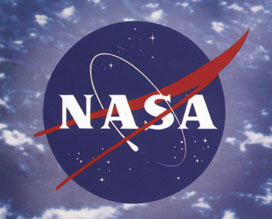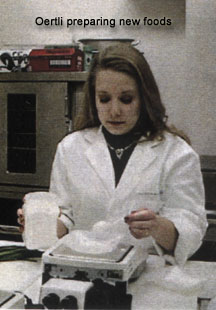|
Food
Out of This World
Tech Alumna Prepares Food for Space |
||||
| by Brenda Schumann | ||||
|
|
||||
 Have
you ever wondered how astronauts eat in space or who prepares their food?
For Connie Oertli, a 1994 Texas Tech Food Technology graduate, this question
has an answer. Have
you ever wondered how astronauts eat in space or who prepares their food?
For Connie Oertli, a 1994 Texas Tech Food Technology graduate, this question
has an answer.Oertli, a food scientist for Lockheed Martin, develops and improves food for space travel at the Johnson Space Center in Houston. Her main emphasis is developing food for two different programs — the International Space Station Food Program and the Space Shuttle Food Program. "Developing food products for use in space is a fun job that presents new challenges every day," said Oertli. According to Oertli, the International Space Station Food Program focuses on developing new products as opposed to the Space Shuttle Food Program that works to maintain the current food products. The main cause for the difference in the two programs is water availability and product shelf life requirements that depend on mission length. Many of the Shuttle foods are freeze-dried to conserve weight and also because water is readily available for use from the orbiter fuel cells that produce electricity for the shuttle by combining hydrogen and oxygen. On the other hand, there is no readily available water on the Space Station because they utilize solar energy and many of the food  items are thermostablized and have a minimum 12 month shelf life.
items are thermostablized and have a minimum 12 month shelf life. In some instances, the thermostablized food will stay edible for 2 to5 years. "It’s easy to make a good meat loaf, but it’s not easy to make a meat loaf that lasts for three years and has the proper nutrients," Oertli said. Each astronaut has a personal preference menu designed just for them. A dietitian plans or helps plan the menu for each crewmember because the astronauts go to a food session where they taste a wide variety of food items and rate them for acceptablity. The dietitian ensures that each astronaut receives the proper recommended dietary allowances of vitamins and minerals based on personal characteristics such as weight, age, and activity level. The astronauts can choose from nearly 200 foods when planning their menu selections. "Food is the only luxury astronauts have when they’re in space. When it comes to eating, they want to eat exactly what they want, and they want it taste good," Oertli said. Each year about 20 new foods are developed. Most recently the focus of the development has been on thermostabilitzed food for the Space Station because the crews stay on the station for four months at a time and their food requires a longer shelf life with no extra water. "Next year we may start developing frozen foods because the Assembly Complete Phase of the International Space Station is scheduled to have freezers for frozen storage. This will allow the astronauts to eat just as we do here on Earth," said Oertli.  The challenges
of developing food for space travel will continue to expand because of the
reality of the International Space Station. The challenges
of developing food for space travel will continue to expand because of the
reality of the International Space Station."I am very grateful to Lockheed Martin for giving me this job. A lot of food scientists do not get to work in product development, and I consider myself lucky that I do; especially developing food for astronauts who eat my food in outer space," Oertli said. The space food systems laboratory is a group composed of food scientists, dieticians, packaging engineers and technicians. Oertli is proud to be one of the three food scientists that actually develop the food for NASA. "We’re a small group and don’t really fit in here with all of the engineers, but we still work together to get things accomplished," Oertli said. "There will never be hundreds and hundreds of people who have developed food for astronauts. So you can bet, I’ve got my ‘Guns Up,’ and standing proud as a Red Raider." |
||||